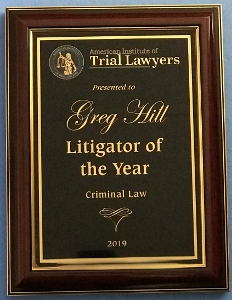Reducing Bail & Knowing When Someone Will Be Released
We are Greg Hill & Associates. If you or a family member have questions concerning bail or when someone will be released, we can help you.
In reducing bail or requesting own recognizance (OR) release of someone in custody, it is assumed here that bail was set by law enforcement upon taking custody of someone you care about, but cannot afford to post the money set as bail or arrange with a bail bond company to post a bond.
Bail is set by law enforcement according to a table (called a schedule) that sets a dollar amount for certain crimes and allows increases based on one’s prior criminal history, or enhancements based on the facts of the crime (i.e. if the crime was committed to benefit a gang, if a weapon such as a firearm was used, hate crimes, etc.).
Bail Reduction Case Result Summaries
To verify that the bail amount is accurately calculated, one can look at the same schedules that police use by clicking on the following link.
https://www.greghillassociates.com/other-helpful-information.html#bail.
We often find that police set bail lower than the amount we believe may apply. When this takes place, it may be prudent not to seek a decrease in bail, as such a request can result in bail being raised instead.
However, if one wishes to challenge the level of bail or request the own recognizance (OR) release of someone, it is best to do so in a written motion for the reduction of bail under Penal Code § 1275. Such a motion must be served and filed no later than ten days prior to the hearing on bail.
 Twin Towers LA County Jail Downtown LA
Twin Towers LA County Jail Downtown LAThis ten-day notice period for a bail motion is meant to allow for investigation into protection of the public, the seriousness of the offense charged, and the probability of the person in custody appearing at the hearings for the case if released on lower bail or even O.R. release.

Protection of the public refers to the danger the individual poses for repeating the same type of crime if released. It can also take into consideration the person’s prior criminal history if it suggests the person may contact witnesses to dissuade or intimidate the victim, the victim’s family or any witness from coming to court or how to testify by threats of force, or even killing such people. This analysis should include evaluation of whether the underlying crime was for the benefit of a criminal street gang and whether defendant is an active member of such a gang.
The seriousness of the offense charged should evaluate the use of a weapon, the injury or injuries involved, the vulnerability of the victim, the abuse of a position of trust or authority of the defendant, the overall planning or sophistication of the crime and the cooperation of defendant with police, once defendant was apprehended.
Bail & Release Contact Information
Bail Schedules for Southern California Counties
In evaluating the seriousness of the crime, one should understand that the judge is permitted, for purposes of determining bail, to consider as true all allegations in the police report and to evaluate whether defendant is in fact guilty of the crime charged. The presumption of innocence does not really apply, in other words, in an evaluation by the judge of bail due to public safety concerns.
 Torrance Superior Courthouse
Torrance Superior CourthousePerhaps most important in determining the level of bail is determining the likelihood that defendant will return to court if released on lower bail or even O.R. In this regard, the judge will consider the defendant’s past history of coming to court and whether any bench warrants for defendant have been issued in the past.
If you have questions or concerns regarding bail and release, please call us today for a free 45 minute consultation. (310) 782-2500.
http://www.sylviasbailbonds.com/
San Pedro, CA
http://sylviasbailbonds.com/
Long Beach, CA
http://lopezbail.com/
Redondo Beach, CA
| Facts About Bail & Release | |
| Before a suspect can be released from jail prior to their court date, as a condition of release, the sheriff sets bail. The suspect must either pay the jail the full bail amount (cash bail), which is very unusual, or go through a bondsman. The amount of bail is determined by a court devised “schedule” for the particular charges. The schedule varies by county. Many times police officers allege multiple charges against the suspect, which has the practical effect of increasing the amount of bail necessary for release and perhaps making the difference between someone being released and staying in jail. If an arrested person pays the jail directly, they must pay the bail amount in full. If this method is chosen and the defendant appears at all times during the case, the money will not be returned for at least 2 to 3 months following the resolution of the case. Resolution of the case includes the assignment to a drug diversion program, a commitment to a correctional facility, and of course, dismissal of the case. If an arrested person decides to use a bail bondsman, the bondsman charges a fee (normally 10% of the total bail amount). The fee is non-refundable and is for the bail bond company bearing the financial risk that the suspect may not show up in court on the appointed date. If a suspect fails to appear (“skips bail”), the bail will be forfeited unless the suspect surrenders or is returned to custody and bail is reinstated. If family or friends post cash bail and the arrested person does not appear in court, the family or friends usually lose their money. The only way bail can be returned is if the person is returned to custody within six month after the court declares a forfeiture on bond and the judge agrees to reinstate bail. However, if bail is posted through a bondsman, the bondsman is responsible for bringing the accused back to court. If the bondsman fails to do so, it is the bondsman who must pay the entire bail amount. It is important to hire an experienced criminal defense attorney who can prepare the case to argue to either lower the bail or ask the court that the accused person be released on their own recognizance. This will save the accused and his family the stress of having to get money together to post bail. It is important to hire an experienced criminal defense attorney who can prepare the case to argue to either lower the bail amount or ask the court that the accused person be released on their own recognizance. This will save the accused and his family the stress of having to get money together to post bail. | |
| Benefits To Selecting Greg Hill & Associates: | |
| 1 | Available every day, every hour. 24-hour in-person answering. Our office will often go to the jail when the Client is initially arrested to persuade the police to set bail at a low level or agree to have the client released on his or her own recognizance. |
| 2 | Over 35 years experience, hundreds of criminal cases handled, a track record of success, over 100 criminal trials, tough negotiators and savvy enough to use their familiarity with local judges and district attorneys to your advantage. |
| 3 | Top quality services at reasonable rates. |
| 4 | Free 45 minute consultation. |
| 5 | All major credit cards accepted. |
| 6 | Immediate, courteous response. |
| 7 | Office near Torrance Courthouse with free parking. |
Your freedom is too important to entrust to just any attorney. You need a law firm that is familiar with the best bail bondsmen who are available when you need help and who are competent. Greg Hill & Associates is that firm. We are one of Southern California's most experienced criminal defense law firms, with over 30 years of experience. Greg Hill & Associates has successfully assisted hundreds of people in bail matters.
IF YOUR FAMILY MEMBER WAS ARRESTED AND IS IN CUSTODY, CONTACT OUR OFFICE FOR A FREE 45 MINUTE CONSULTATION. WE WILL ARRANGE FOR YOUR LOVED ONE'S RELEASE FROM JAIL AS SOON AS POSSIBLE. (310) 782-2500.
 Greg Hill & Associates Home
Greg Hill & Associates Home




















